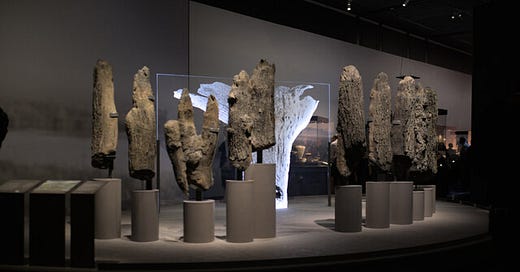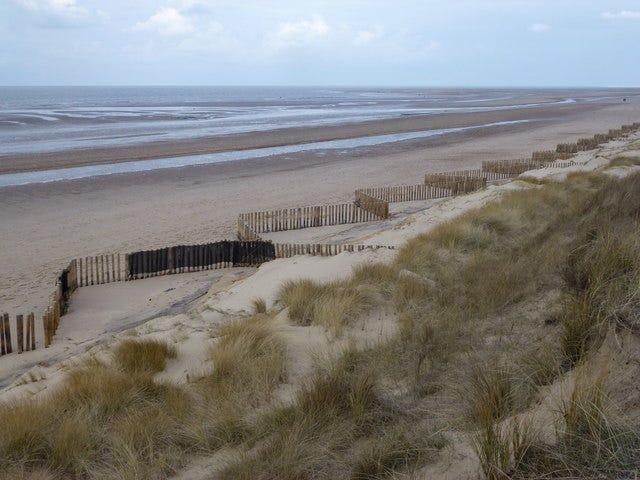A contemporary exhibit depicting Seahenge, lost in the vast maw of the British Museum. (Bob Harvey/geograph)
The discovery of Seahenge on the wide open and peaceful space that is the beach at Holme-next-the-Sea caused a lot of excitement that was, swiftly, tinged with no little controversy.
Might it had been better if it had never been found at all?
There are those who will certainly feel that way.
Seahenge was a 4000 year old timber circle that dates from the Bronze Age. It had lain hidden in the sand until 1998 when the ever present coastal forces of erosion and change were exacerbated by a combination of strong winds and high tides, the result of which laid the awe inspiring vista of Seahenge visible once again.
It’s discovery and the swift conclusion as to its age and purpose caused a huge amount of controversy when English Heritage, working alongside the admirable Norfolk Archaeological Unit agreed to fund Seahenge’s removal from the beach, choosing to do this rather than, as has since been done at the site of the Roman fort in nearby Brancaster, opting to measure and examine it in-situ before, in Holme’s case, letting the combination of time, sea and sand cover it up again.
Many people, especially those living locally thought that is exactly what should have been done. Yes, of course, make use of the unique opportunity to examine and research this ancient and unique site.
But once you’re finished then leave it alone.
The wide open space of sea, sand and sky at Holme next Sea beach (Richard Humphrey/geograph)
You wouldn’t, after all, haul Stonehenge off to a Museum, why should Seahenge be any different? It was there for a purpose and should, in the opinion of many, self included, have been left well alone.
One concern was that Seahenge would end up in London, miles away from its ‘home’ and, in all likelihood, shuffled off into hidden storage somewhere once the initial interest in it had ebbed. If it was, the argument went, to be fated to a future in a cold, dark and airless place, then let it be in the sands at Holme rather than a cellar in London WC1B.
A painting of Seahenge in situ by local artist Ken Hayes (Ken Hayes)
The counter argument offered was that now Seahenge was exposed, the risk of damage to the site, due to it’s exposure to the air as well the behaviour of certain elements of the general populace (who might have felt inclined to hack a piece of it off so they could take a souvenir back home to Kensington with them) was considerable.
There is a precedent. Victorian visitors to Stonehenge were invited to do exactly that with hammer and chisels being freely provided to curious day trippers.
As far as Seahenge was concerned, some people objected to it being moved on ancient religious grounds whilst others felt it was just another case of the establishment turning up in Norfolk in their flash cars and fancy suits and deciding (not for the first time) that they, rather than the local people, knew best.
One high profile objection to the site being left undisturbed was raised by the Norfolk Wildlife Trust who pointed out that, as the timber circle lay on the edge of the Holme Dunes Nature Reserve, the crowds of people who would visit Seahenge would disturb the reserves feeding waders and other wildlife.
This was a valid point as it was estimated that around 5000 people visited the beach in the days after the discovery, numbers that are more associated with Great Yarmouth’s Pleasure Beach rather than a quiet and idyllic spot like Holme.
Cold logic eventually won the argument. Archaeologists moved onto the site and, despite a fractious relationship with objectors began, within the window that tide movements allowed (usually up to four hours a day) to remove the timbers.
They had, without their protective covering of peat and sand, already started to decay in-situ so were taken to the Bronze Age Centre at Flat Fen in Peterborough where they were placed in fresh water tanks and scrupulously cleaned before being moved to the site of the Mary Rose Trust in Portsmouth where, alongside the timbers from Henry VIII’s great warship, they were vacuum freeze dried in readiness for display.
Part of Seahenge today, locked away and kept antiseptically clean at King’s Lynn Museum (John M/geograph)
Seahenge now has a permanent home at the splendid museum in King’s Lynn which at least means it remains in its county of origin and is easily accessible to those whose distant ancestors built it in the first place.
Me? I still maintain they should have left it alone and in peace rather than in pieces.







